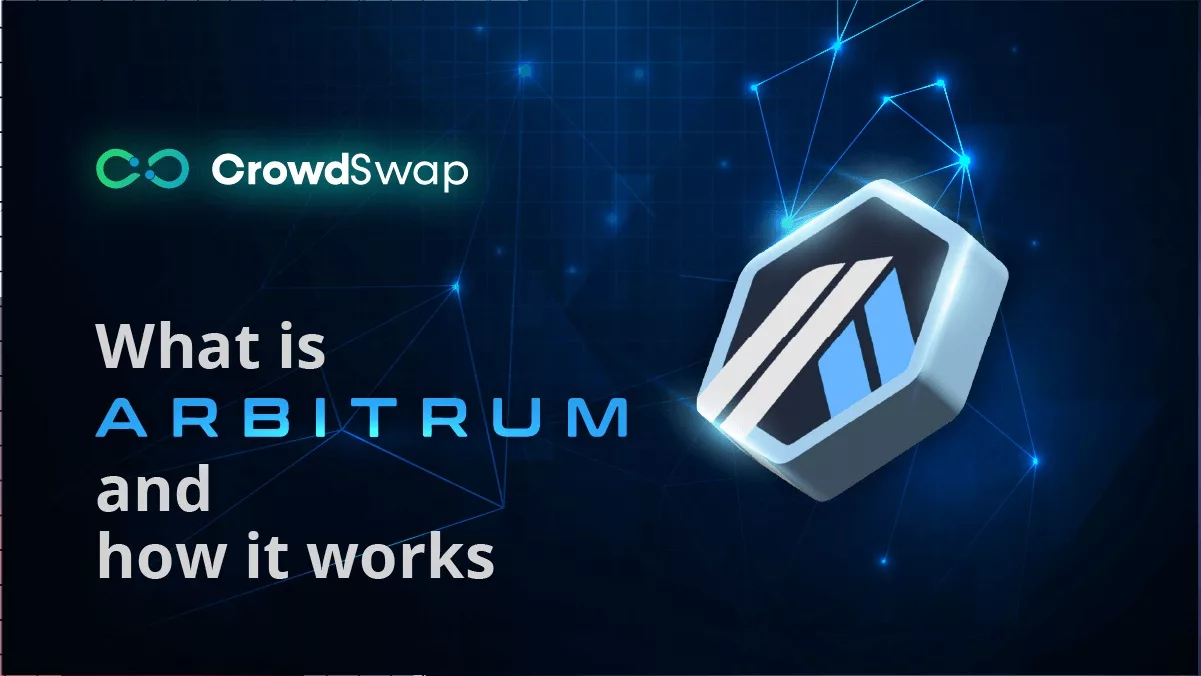Arbitrum is one of the leading layer two solutions for Ethereum. Layer 2 solutions aim to address the scalability and cost issues of Ethereum by moving most of the computation and storage off the main chain while still relying on its security and consensus.
Layer 2 solutions will play a crucial role in the growth of decentralized applications (DApps) and decentralized finance (DeFi) until Ethereum 2.0. Arbitrum uses a technique known as optimistic rollups to record batches of submitted transactions on the Ethereum main chain (layer 1) and executes them on cheap, scalable layer 2 sidechains while leveraging Ethereum to ensure correct results. Arbitrum uses optimistic rollups, which assume that transactions are valid unless proven otherwise by Fraud proof. Arbitrum offers 7x more throughput than Ethereum and lower fees without sacrificing security. Arbitrum has two main products: Arbitrum One, which is focused on decentralized finance (DeFi) applications, and Arbitrum Nova, which is focused on web3 social and gaming applications.
What is the history of Arbitrum:
Arbitrum was developed by Offchain Labs, a blockchain research and development company founded in 2018 by Ed Felten, Steven Goldfeder, and Harry Kalodner. The company first proposed the solution through a presentation and the Arbitrum whitepaper (PDF) at Princeton University in 2018.
Offchain Labs formed the network on September 1, 2018. The blockchain was created to improve Ethereum, especially when it comes to gas fees and the speed of transactions.
The official launch of the Arbitrum One network took place on August 31, 2022. Arbitrum One is a layer-two blockchain for Ethereum using optimistic rollups as scaling technology.
Arbitrum integrated with Coinbase on February 16, 2022. Coinbase is one of the world’s largest and most popular cryptocurrency exchanges.
The proposed evolution of Arbitrum into a decentralized autonomous organization (DAO) is scheduled for March 18, 2023. The DAO will be governed by the ARB token holders, who Can participate in decentralized governance decisions that will be automatically executed on-chain once passed.
What is an Arbitrum ecosystem:
Arbitrum is an innovative layer-two scaling solution that significantly benefits the Ethereum ecosystem. It is one of the top layer2 scaling solutions for Ethereum, designed to give developers a more scalable, faster, and more efficient ecosystem to deploy Ethereum-based decentralized applications (dApps).
Arbitrum has the potential to drive significant growth and innovation in the blockchain space by providing faster transaction times, lower gas fees, and improved scalability. It processes transactions on its proprietary side chain and relays the new chain state to the Ethereum main net.
The Arbitrum ecosystem is well-constructed since every necessary component is ready for operation and waits for future incentives to reach its full potential. The participation of leading Ethereum-based protocols in Arbitrum creates both positive and non-positive impacts on the ecosystem.
What are Arbitrum features:
Arbitrum uses an optimistic rollup to process transactions off-chain and send only a minimal amount of data back to the leading network. Some arbitrum features are low fees, high speed, privacy, and compatibility, which are explained more here.
Low fees: Arbitrum ensures that transactions cost cents instead of tens of dollars on Ethereum.
High speed: Arbitrum can process thousands of transactions per second, compared to around 15 on Ethereum.
Privacy: Arbitrum hides the details of transactions from the public, making them more secure and private.
Compatibility: Arbitrum supports any smart contract or DApp that runs on Ethereum without requiring code changes.
What are the benefits of Arbitrum:
It reduces gas fees and transaction latency by offloading most computation and storage to the Arbitrum network.
It maintains the security and decentralization of Ethereum by relying on its consensus mechanism and smart contract capabilities.
It supports any Ethereum-compatible smart contract, tool, or wallet, making it easy for developers and users to migrate to Arbitrum.
It offers more privacy than other layers two solutions by hiding the details of transactions and smart contracts from the public.
How Arbitrum reduces the gas fee in ETH:
Arbitrum reduces gas fees by developing on the Ethereum blockchain with off-chain data storage facilities and allowing smart contracts to be validated in batches while compensating validators for their effort.
The gas fee is an amount of ether (ETH) required for an Ethereum blockchain network user to transact on the network. Gas fees compensate Ethereum miners for verifying transactions and securing the network.
Gas fees are denoted in gwei, which is a denomination of ETH – each gwei is equal to 0.000000001 ETH (10-9 ETH). For example, instead of saying that your gas costs 0.000000001 ether, you can tell your gas costs one gwei. The gas fee for a transaction depends on the gas limit and the gas price. The gas limit is the maximum amount of gas units a transaction can consume, and the gas price is the amount of gwei that the user is willing to pay per gas unit. The gas fee is calculated by multiplying the gas limit and gas fee. Click here if you want to know more about saving on Ethereum gas fees.
What are the risks and challenges of Arbitrum :
Security: Arbitrum does not guarantee security by itself, as it relies on Ethereum’s infrastructure. However, it is still vulnerable to hacking and attacks by malicious users. For example, a forking attack could try to discard blocks with challenges and create a false history of transactions.
Competition Arbitrum faces competition from other layer-2 solutions, such as Optimism, ZKSync, and Polygons. Each solution has advantages and disadvantages, and users may prefer one over another depending on their needs and preferences.
What are the layer two solutions:
A layer two solution is a protocol built on top of an existing layer one blockchain, such as Ethereum, aiming to increase the capabilities of layer 1. A metaphor typically used to describe layer two solutions is a sideroad. A layer two solution offloads computational work from layer one by processing transactions off-chain, increasing transaction speed and throughput. Layer 2 solutions help to scale blockchains by reducing the load on the main chain and lowering the transaction fees. They also maintain the security and decentralizing of the underly blockchain by posting transaction data back to layer one.
What are the differences between layer one and layer two solutions:
Layer 1 and layer 2 are terms that describe different approaches to scaling a blockchain network. Layer 1 is the base blockchain protocol, which defines the network’s consensus mechanism, transaction validation, and security. Layer 2 is an overlaying network that lies on top of the base blockchain and uses a third-party integration to increase the number of transactions processed per second.
The main reason layer one and layer two solutions are needed is that blockchain networks face challenges with scalability, which means the ability to handle a large volume of transactions without compromising speed, cost, or security. Blockchain networks are decentralized, meaning they rely on nodes to verify and record transactions.
However, this also means that every node has to process.
What are the differences between Arbitrum and other layer two solutions:
Arbitrum uses Optimistic Rollups, whereas Polygon uses Plasma and ZK-Rollups. Optimistic Rollups assume that transactions are valid unless challenged, whereas Plasma and ZK-Rollups use cryptographic proofs to verify transactions before submitting them to the main chain.
Arbitrum is more decentralized than Polygon, as Ethereum’s network of miners secures it, whereas Polygon is secured by MATIC staking, which is a smaller pool of wealth.
Arbitrum is more compatible with Ethereum than Optimism, as it does not require any changes to existing smart contracts or tools, whereas Optimism requires some modifications to ensure compatibility.
Arbitrum vs. Optimism vs. Polygon:
Arbitrum, Optimism, and Polygon are three popular layer-2 solutions for Ethereum. They aim to improve its scalability, throughput, and gas fees by taking transactions off the main chain and posting them back later. They use optimistic rollups, zero-knowledge rollups, and side chains to achieve this goal.
Polygon has the highest speed of up to 65,000 transactions per second (TPS), followed by Arbitrum with nearly 40,000 TPS and Optimism with 2,000 TPS. Polygon supports other layer-2 solutions such as plasma chains, ZK rollups, and optimistic rollups within its sidechain. However, Polygon is only partially decentralized as it relies on a set of validators to secure its network.
Arbitrum and Optimism are optimistic rollup solutions that assume transactions are valid unless challenged by fraud-proof. They are compatible with the Ethereum virtual machine (EVM) and allow developers to deploy smart contracts without modifying them.
There is no definitive answer to which layer-2 solution is better, as each has advantages and disadvantages. It depends on your preferences, needs, and goals as a user or developer. Consider factors such as security, decentralization, compatibility, usability, and adoption when choosing a layer-2 solution for Ethereum.
What is Arbitrum One:
Arbitrum One is the first publicly accessible network powered by Arbitrum, a layer-2 scaling solution for Ethereum. It uses a technique called Optimistic Rollup, which allows transactions to be executed off-chain on a layer-2 network while only posting the transaction data to the leading Ethereum network for verification. This way, it can increase the transaction throughput and reduce the gas fees on Ethereum. Arbitrum One is compatible with the Ethereum Virtual Machine (EVM). Any smart contract or DApp on Ethereum can also run on Arbitrum One without any code changes. Arbitrum One is home to many DeFi DApps.
Read more: What is DeFi?
What is Arbitrum Nova:
Offchain Labs build Arbitrum Nova, the same team behind Arbitrum One, another layer two solution that use optimistic rollups. Arbitrum Nova shares the same code base with Arbitrum One but has a different security model and target audience. Transactions on Arbitrum Nova are fast and cheap, making it suitable for applications that require frequent and interactive actions on-chain, such as games, NFTs, social tokens, and community points.
Arbitrum Nova uses a technique called Nitro, which relies on a data availability Committee (DAC) to ensure that transaction data is always available and can be verified by anyone. The DAC consists of 12 reputable members from the web2 and web3 space, such as Reddit, Coinbase, Binance, and Chainlink. The DAC provides Certificates of data for each batch of transactions submitted by the sequencer.
Arbitrum Nova offers ultra-low transaction costs by moving most of the computation and storage off-chain while maintaining compatibility and interoperability with Ethereum.
Arbitrum Nova has its native token, ARB, used for governance and paying fees on the network. ARB tokens were airdropped to eligible users and DAOs in March 2023 based on their interaction with the Arbitrum network before February 6th, 2023. ARB tokens are in various exchanges platform that supports ARB trading, like CrowdSwapp.
How does Arbitrum handle disputes and fraud proofs:
Arbitrum handles disputes and fraud proofs by using a technique called Optimistic Rollup. This means that transactions are assumed to be correct unless someone challenges them and proves them wrong. Anyone can be a challenger and post a bond to initiate a dispute. The dispute is then resolved by executing the transaction on the Ethereum main net and comparing the results with the Arbitrum layer-2 network.
What is optimistic technology in Arbitrum?
Optimistic technology is a layer-2 scaling solution for Ethereum that uses Optimistic Rollup. It allows transactions to be executed off-chain on a layer-2 network while only posting the transaction data to the main Ethereum network for verification. This way, it can increase the transaction throughput and reduce the gas fees on Ethereum.
Arbitrum is one of the most popular Optimistic Rollup implementations, along with Optimism. It aims to offer a fast and secure environment for decentralized applications (DApps) on Ethereum. It is compatible with the Ethereum Virtual Machine (EVM), which means that any smart contract or DApp that runs on Ethereum can also run on Arbitrum without any code changes.
What is an Arbitrum token (ARB) :
ARB token is the native token of Arbitrum. It is used to pay for transaction fees on the Arbitrum network, which are lower than on Ethereum due to moving most of the computation and storage off-chain also enables decentralized governance of the Arbitrum ecosystem, as holders of ARB can create and vote on proposals that affect the features, protocol upgrades, funds allocation and election of a Security Council.
ARB token was launched on March 23rd, 2023, distributing 12.75% of the total supply of ARB tokens to eligible recipients and DAOs. The current circulating supply is 1.28 billion ARB tokens, and the entire supply is 10 billion. Several major cryptocurrency exchanges like CrowSwap support ARB in their program.
Trade Effortlessly
Ready to dive deeper? Our crypto exchange is simple and user-friendly, making trading a breeze
Conclusion:
In this article, we tried to give valuable information and extra detail about arbitrum to help better understand the benefits and development of layer two solutions and how arbitrum provides faster and more secure transactions. We hope this information is helpful and valuable for users.
FAQ:
What is Arbitrum’s effect on blockchain space?
Arbitrum is one of the leading layers two solutions for Ethereum, which has the potential to drive significant growth and innovation in the blockchain space by providing faster transaction times, lower gas fees, and improved scalability.
What are ARB tokens used for?
ARB token is the native token of Arbitrum, and it can be used for decentralized governance of the Arbitrum ecosystem and trade in many cryptocurrency exchanges.
What does arbitrum do?
Firstly It will reduce gas fees and transaction latency, secondly maintains the security, and can support any Ethereum-compatible smart contract. It mainly offers more privacy than the other layer two solutions.













